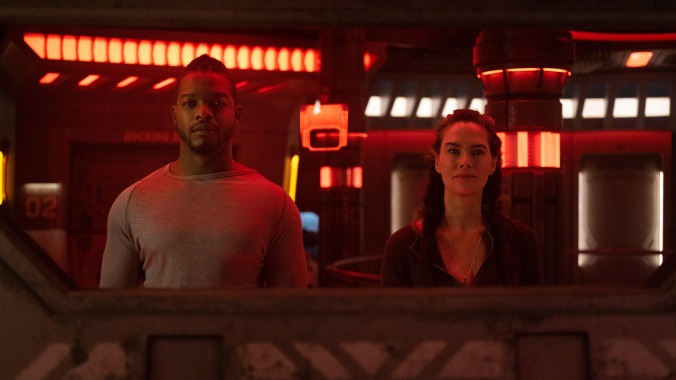Beacon 23 review: An enjoyable, if wildly uneven, sci-fi series
Lena Headey and Stephan James go head to head in this MGM+ drama set in an intergalactic lighthouse

In the world Beacon 23 imagines, humankind has reached the farthest corners of the universe. Beacons—intergalactic lighthouses designed to help spaceships navigate treacherous terrain in outer space—have been erected all over. It’s in one of those that this adaptation of Hugh Howey’s same-titled novel is set. The arrival of a strange visitor disturbs what appears to be the lonely and alienating life of the beacon’s sole keeper, who’s only had his AI to keep him company for perhaps way too long. With an intriguing premise that splinters into a rather fragmented first season made up of plenty of self-contained episodes, this MGM+ series, which premieres November 12, is an enjoyable if wildly uneven ride.
When a ship crashes near Beacon 23 (due to what appears to be a system malfunction), its keeper has no choice but to retrieve the one person who survived the improbable wreckage. But when Aster (Lena Headey) awakes aboard this sleek-looking outer-space post, she’s immediately wary of the man (Stephan James) who introduces himself as the beacon keeper. We soon learn, though, that the two are not who they appear to be. Moreover, their arrival at Beacon 23 unearths hidden agendas that pit them against one another—and against the beacon’s AI, BART (voiced by Wade Bogert-O’Brien), who’s intent on getting justice for some bloodshed that predated Aster’s arrival.
The mystery surrounding why Aster has wormed her way into this beacon and why this keeper (who may not be who he says he is) has found himself stranded right alongside her makes for an intriguing proposition. Their mutual mistrust lets Headey and James color in much of the wounded solitude that’s kept these two figures alive amid a world run by a craven corporation that, with the help of AI all over the universe, has let many a planet (like Aster’s own) starve and die in the process. By the time the two are forced to work together to fend off increasing threats from the outside world (from wreckers, former allies, powerful AI, and, curiously, an “Artifact” that may prove there is alien life out there after all), this unlikely pair come to anchor a provocative new entry in 21st century TV sci-fi fare.
Beacon 23 is at its best when its laser focus stays on its two protagonists as they try to figure out if they’re friends or foes—and while, in the process, they interact not just with BART but with Aster’s personal AI, Harmony (Natasha Mumba), both of whom feel like prescient characters amid ongoing conversations about the role artificial intelligence can play in our day-to-day lives. Indeed, all four actors here are truly engaging. Headey rightly captures the wearied frustrations of a woman who can only depend on herself to survive, while James (in a bit of a Homecoming echo) imbues his character with wounded frustration that makes him equally irascible and vulnerable. And Bogert-O’Brien (using only his voice) and Mumba (appearing as a hologram throughout) carefully color in their respective AI with enough personality to make them welcome heirs to HAL. At times, you almost forget they’re facsimiles of people and thus perhaps not as trustworthy as they appear.
But no sooner has Beacon 23 set up such interesting discussions about who you can trust and what you may be pushed to mistrust that it begins weaving in a decidedly ambitious mythology that involves previous beacon keepers, blue-hued rocks made up of an element not yet discovered, and political fighters with pseudo-spiritual inclinations—all of which point us to the importance of the titular lighthouse and those now housed there.
The scope of the show, then, spirals outward quite quickly—especially as episodes soon introduce us to folks whose fate has set the very plans in motion Aster finds herself in the middle of, even if she can’t quite piece it together all by herself. And some of those storylines are much more intriguing than others. Any series, for instance, that gifts us an entire entry where we get to witness the talents of one Barbara Hershey, for instance, deserves our compliments; hers is a brilliant episode-length meditation on the dangers in forgetting AI is a tool and not, in fact, a friend (or a child). Others are less successful. And so, from episode to episode—perhaps echoing the short-story format of Howey’s novel—Beacon 23 can’t escape a sense of fruitless fragmentation—even if, as the final installments of its freshman season suggest, there is indeed a well-laid plan and a well-reasoned purpose for this shuttling back and forth between past and present.
Perhaps this is the kind of series that would, in a different television landscape, have benefited from a longer first season. (Its second season, announced and shot already, will be coming soon enough.) The heady slow burn of its first few episodes is a balm compared to the hectic, expository-heavy ones that follow and get bogged down in the kind of messianic plotting that’s sure to give Battlestar Galactica fans a bit of painful deja vu.
Beacon 23 premieres November 12 on MGM+